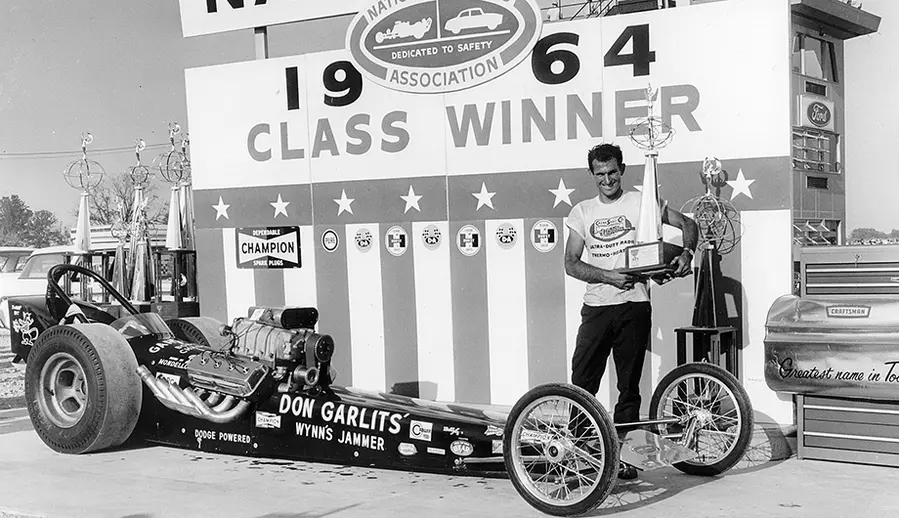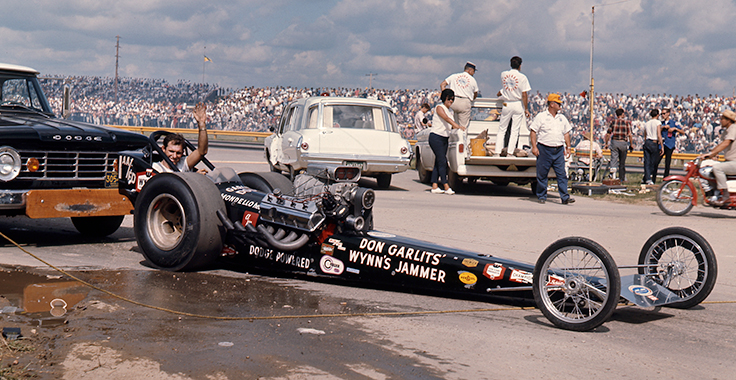

Garlits went 'Big' in Indy in 1964 for first of eight U.S. Nationals victories


As we build up towards the massive celebration that will be the 70th running of the famed NHRA U.S. Nationals, we’re looking back at some of the great performances and Indy dominations, starting with the 1960s, and you can’t talk about Indy in the 1960s without talking about Don Garlits.
Garlits won Top Fuel at the Big Go three times in the 1960s, but considering that Top Fuel did not run at the event until 1964, that means he won three of six, or exactly half of them, in the decade (see, I’m as good with math as I am with words).
You might have seen the story posted on NHRA.com earlier this week highlighting Garlits’ 1960s successes in Indy, but I’m here to turn the focus back exactly 60 years to “Big Daddy’s” first Indy win, and surely one of his weirdest.

Before 1964, Top Eliminator was the biggest headliner at the event, won in gas-burning dragsters by legends such as Calvin Rice (1955 in Great Bend, Kan.), Melvin Heath (1956 in Kansas City, Mo.), Buddy Sampson and Ted Cyr (1957 and ‘58 in Oklahoma City), Rodney Singer and Leonard Harris (1959 and ’60 in Detroit), and Pete Robinson, Jack Chrisman, and Bobby Vodnik (1961, ’62, and ’63 in Indy). Of course, for the large majority of this time (1957-63), the usage of the nitromethane fuel that makes Top Fuel crackle and pop was banned by the NHRA.
Nitro made its return to NHRA for the 1963 NHRA Winternationals, which Garlits won in his winged Swamp Rat V, but the ’63 Nationals was still a gas-only affair, won by young Vodnik in the Hobbs & Hirata entry over Garlits, who red-lighted against the teenage phenom at the first NHRA national event to utilize the Christmas Tree starting system. Garlits also had been the runner-up behind Chrisman the year before, so he was juiced and ready for a big win when the cackle came calling in Indy ’64.
The 1964 season had been a real mixed bag for Garlits. He had failed to qualify his own car at the Winternationals, but he subbed (for unexplained reasons) for Norm Weekly in eliminations and made it to round two, where he red-lighted against Kenny Safford. (Crazily, Don Prudhomme had also DNQ’d at the event in the vaunted Greer-Black-Prudhomme entry.)

After taking over the No. 1 spot in the Drag News 1320 list by beating Weekly in a post-Winternationals race in Pomona, Garlits was runner-up behind Connie Kalitta at the March Meet, an event that meant a lot to the era’s nitro pilots (Garlits would finally win it the next year in his seventh try). But until the Indy win, the biggest feather in “Big Daddy’s” cap that year clearly was his barrier-breaking 200-mph run in August at Island Dragway in New Jersey, widely recognized as the first NHRA 200-mph pass.
In the mid-1960s, winning Top Fuel in Indy was not as straightforward as it is today. Back then, drivers also took part in class eliminations, and for Top Fuel drivers, that meant AA/FD. Sunday’s winner of the AA/FD class then sat out Monday’s final eliminations, and then raced the winner of that eight-car field for all of the money, marbles, and chalk.

Garlits’ Swamp Rat VI-B Wynn’s Jammer whipped up on the field in Sunday’s eight-car class eliminations field, defeating Willey Fallon in the Shreveport Dragway Special and George Van with back-to-back 7.80s, then, after a 7.90 semifinal solo against a broken Don Westerdale, a scintillating 7.77 in the final to defeat Kalitta’s 7.85.
While Garlits’ class win was not especially big news — he had also won in the AA/D class the year before — Kalitta’s 200.00-mph blast on Friday was, as it was not only the first 200-mph pass in Indy but also the first at an NHRA national event.

Kalitta (above) was also part of Monday’s eight-car field, hoping for another shot at Garlits, but he fouled against Tom Hoover. Winternationals champ Jack Williams also advanced in the Crossley, Williams & Swan entry, ending Vodnik’s bid for a second straight, while "Stormin' Norman" Weekly defeated Van, and “Gentleman Joe” Schubeck bested Maynard Rupp.
And here's where it gets weird.
Hoover’s win over Kalitta was a costly one, as he blew the engine, and a similar fate befell the 360-inch Chrysler in the framerails of the Weekly-Rivero-Fox-Holding "Frantic Four" machine. Meanwhile, Schubeck’s Lakewood Chassis Special lost the rear end in its winning pass against Rupp.
Here’s how NHRA National Dragster described the frantic between-rounds thrash in our Sept. 11 issue:
The crews immediately went to work on the broken racers. Both Hoover and Weekly's machines were stripped to the bare chassis to make it easier to work. Schubeck, with only a rear end to replace, was sitting in a little better shape as far as his one-hour deadline for the next round of Top Fuel was concerned.
But he wasn't reckoning with the "sticky fingers" of the surrounding spectators. When the rear end was located with the help of the public address system, it was quickly installed. Everything, that is, except a short U-joint and shaft designed especially for Schubeck's car. Someone had walked off with it during the fast switch. The nearest replacement was at Schubeck's shop in Lakewood, Ohio.
After repeated pleas by Schubeck over the public address system, the unit was finally located, but time had run out on all three of the crews who were working so frantically on their cars.
After a "generous" reading of the watches, the one-hour time limit came and went, and Jack Williams rolled to the starting line to solo for the final run for the Low Eight victory and a chance to run Garlits for the coveted Top Fuel Eliminator title.

Williams did not take it easy on his solo pass, knowing that Garlits had run in the 7.70s on Sunday. Williams blasted to a 7.83 at 199.54 mph, just missing punching his own ticket into the 200-mph club. The run ate up a piston, which was expertly swapped out by crew chief Bill Crossley, who was still screwing in spark plugs as they towed to the staging lanes to face Garlits.

There were no reaction timers back then, but this photo shows that Williams jumped out to a lead on Garlits, who poured the coals to his big, bad, black machine and raced by for the lead and the win with a stunning 7.67 at 198 mph, the e.t. almost a full second quicker than the 8.62 that Vodnik ran against Garlits in the 1963 final. Williams’ mill ate two more pistons and slowed to a 7.93 at just 188.66 mph.
Said Williams, "If I have to come in second, I can't think of anyone better than Garlits. He's a real pro. You don't beat Garlits, you just occasionally get by him."
Especially in Indy in the 1960s.

Phil Burgess can be reached at pburgess@nhra.com
Hundreds of more articles like this can be found in the DRAGSTER INSIDER COLUMN ARCHIVE
Or try the Random Dragster Insider story generator



















































